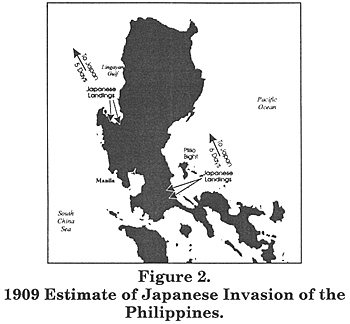In April 1904, in response to a recommendation made by
Army Chief of Staff Lieutenant General Adna R. Chaffee, Secretary of
War William Howard Taft directed the Joint Army Navy Planning
Board to:
agree upon a series of practical problems (taking them in the
order of their assumed importance) which involve cooperation
of the services, and for the execution of which in time of
emergency the two staffs will be responsible.
[41]
The Joint Board's solutions to these "practical problems" would
become war plans signed by the two service secretaries. This was the
first joint deliberate planning system in American history.
Admiral Dewey directed the chiefs of the: two war colleges,
Admiral Henry C. Taylor and General Tasker H. Bliss, to submit
recommendations on how best to get the study underway. 42 Bliss
submitted a 21-page paper, which shaped American war plans for the
next 30 years. He assumed that the enforcement of the Monroe
Doctrine, which he pointed out at the time of the War with Spain was
the "only" American foreign policy, would be the most probable cause
of America's future wars. Significantly, Bliss reasoned that the
acquisition of the Philippines expanded the Monroe Doctrine beyond
the American hemisphere. He concluded that the major European
powers would not likely attack the United States itself because
diversion of military resources would weaken them in the face of
continental rivalries; and that the real purpose of any violation of the
Monroe Doctrine would be to seize American possessions in our
hemisphere or in the Philippines.
[43]
Accordingly, Bliss's paper recommended that the two services
study the following problems in this order:
2. U.S. at war against two continental European powers [one
of which was sure to be Germany]
3. U.S. at war against a coalition of Britain and Canada; and,
4. U.S. intervention into Mexico "with another foreign
complication" [presumably a European power collecting Mexican debt]. The most virulent of all the potential enemies analyzed by the
Joint Board was Germany. Accordingly, in 1913, these studies led to
the formal plan BLACK, for war between the United States and
Germany.
In 1905, the Russo-Japanese War added another country to
the list of potential enemies of the United States--Japan. Plans for the
defense of the Philippines had previously assumed a European enemy.
[45]
Figure 2: 1909 Estimate of Japanese Invasion of the
Philippines.
These were no mere academic exercises. Diederichs' Japanese war planning
counterpart was an Army officer named Giichi Tanaka, who in the 1906
draft of the Imperial Defense Policy included plans for war against the
United States in the Philippines. [47]
The problem of war with Japan was more difficult than war with
Germany because the distance over which the Navy would have to
project the fleet. In 1914, after 8 years of study, during which the United
States provided for its Pacific interests by signing a number of treaties
(Taft-Katsura, Root-Takahira, and the Lansing-Ishii treaties [48] ), the first edition of War Plan ORANGE for
war with Japan emerged. Making matters worse, in 1902 Japan had
signed an alliance with Britain, which meant that a war with Japan might
involve the United States in a war with Britain as well. The United
States would plan for war with Britain (Warplan RED) until 1921, the
year when the Anglo-Japanese treaty was allowed to lapse.
In 1910, a third source of potential danger emerged in the
American hemisphere. At the beginning of the century the Mexican
government was in the hands of the dictator Porfirio Diaz, who ran
Mexican affairs with an iron fist. Under his rule, however, the Mexican
economy improved, railroads were built, mines and oil wells developed,
and industry expanded. When he was overthrown as a result of the
Revolution of 1910, Mexico was thrown into a period of instability and
violence.
The violence in Mexico was in itself a peril to American
interests, but the real danger of all the revolutionary unrest in the
American hemisphere, of which Mexico was the prime example, was
that hostile powers would emulate Louis Napoleon and exploit
instability for the sake of advancing their own ambitions in the Americas.
German and Japanese advisors were already in Mexico, either in covert
or officially acknowledged status, Consequently, the measures which
were taken to provide security against a threat from Mexico, and which
eventually would be codified into Plan GREEN, were oriented as much
against the Germans and Japanese as against any indigenous Mexican
threat.
Thus, when hostilities broke out in Europe in 1914, the United
States had already contemplated the possibility of war, and had
developed plans for the employment of its military forces for the defense
of its territory and the enforcement of the Monroe Doctrine, territorially
expanded to encompass its new Pacific holdings. It remained an open
question, however, as to whether the country possessed the means to
achieve these objectives.
1. U.S. intervention in a South American country to assist the
government in ousting a foreign power supporting insurgents;
 Beginning in 1906, particularly at the Naval War College, Japan
became the chief adversary for all war planning and war games
[46] (see Figure 2).
Beginning in 1906, particularly at the Naval War College, Japan
became the chief adversary for all war planning and war games
[46] (see Figure 2).
Back to Table of Contents Joint U.S. Army-Navy War Planning WWI
Back to SSI List of Issues
Back to MagWeb Magazine List
© Copyright 1998 by US Army War College.
This article appears in MagWeb (Magazine Web) on the Internet World Wide Web.
Other military history articles and gaming articles are available at http://www.magweb.com